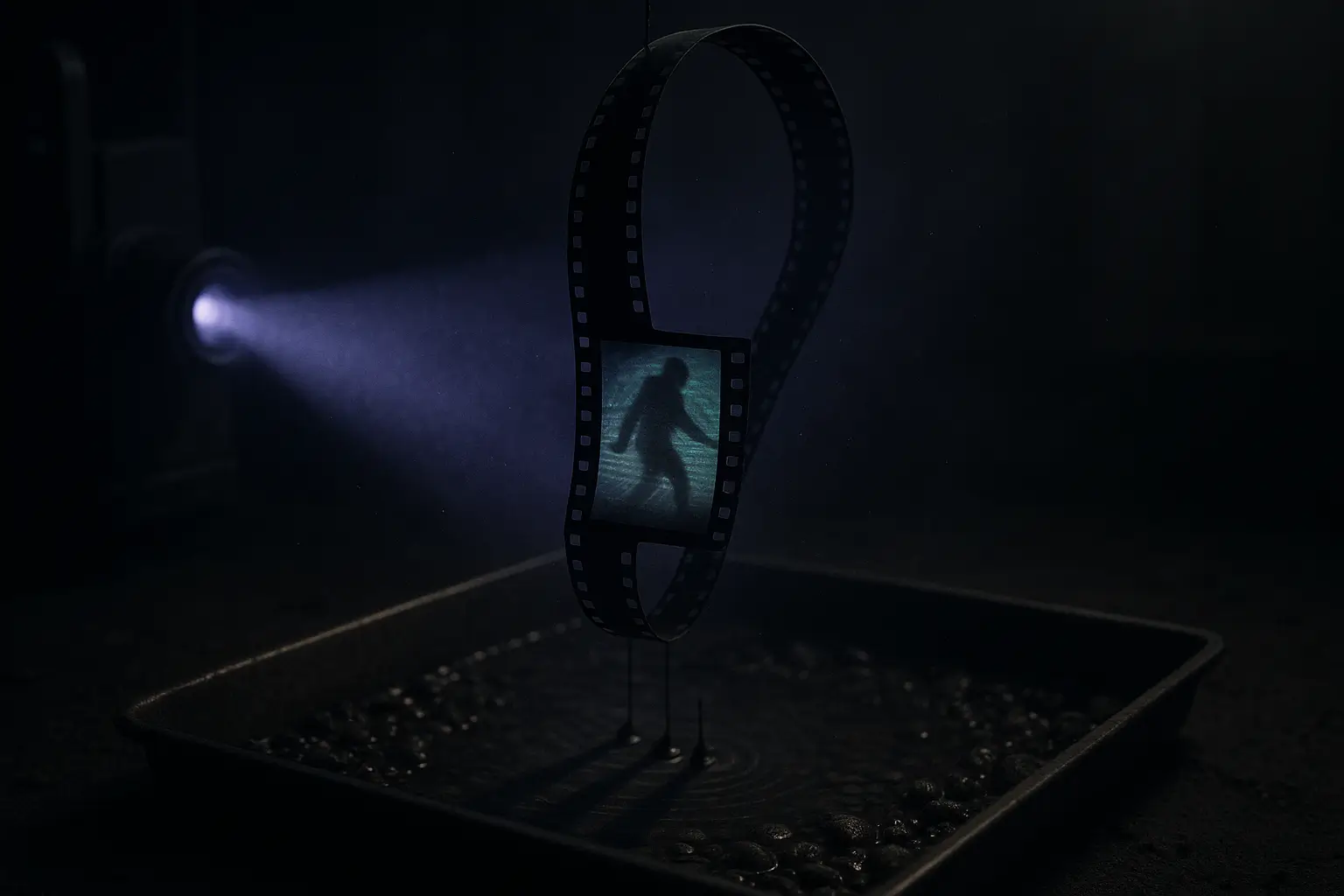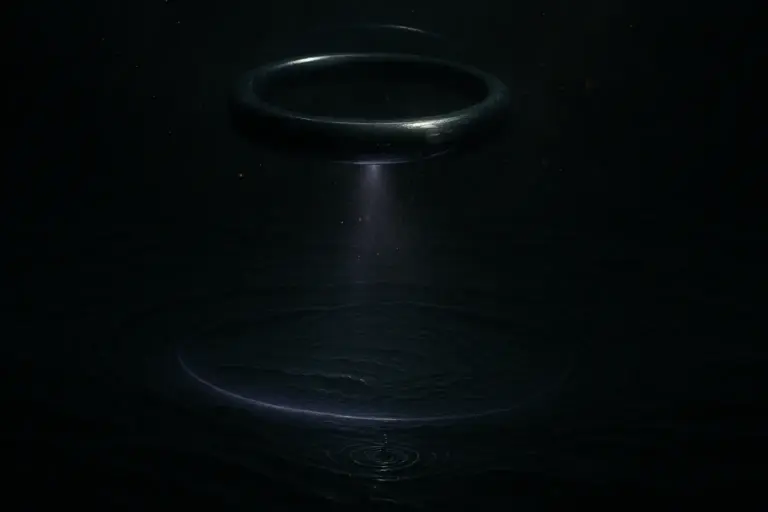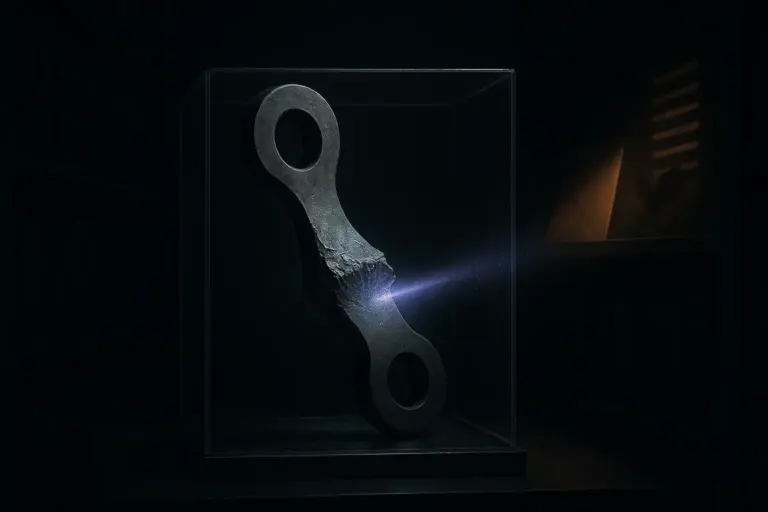Bigfoot Sightings: A Forensic Analysis of the Patterson-Gimlin Film
A single 16mm reel from Bluff Creek anchored decades of bigfoot sightings, its gait mechanics resisting simple explanation under forensic review.
The reel hums like a sewing machine, 16mm teeth catching and releasing, while wet gravel at Bluff Creek reflects a cold October sky. A home movie should wobble, fade, and vanish, yet this one drew lab notes, frame counts, and primate metrics more often reserved for clinical gait studies. In a world saturated with staged wonders, the Patterson–Gimlin film refused to die quietly, becoming the fulcrum on which decades of bigfoot sightings tilt. The contradiction is simple and stubborn: a rough field capture that keeps passing into forensic conversation. Frame 352 looks back, shoulders squared, as if the subject understands it’s being measured. What else the film understands—about speed, about proportion, about the unsaid between splices—remains the line that isn’t crossed, or isn’t allowed to be.
What the Video Adds (Quick Summary)
- Idaho State University technical reviews examined edge integrity, fur-flow dynamics, and soft-tissue behavior across multiple frames
- Highlight behavior and deltoid-trapezius contours suggest volume beneath the surface rather than loose fabric overlay
- Frame rate uncertainty (16 vs. 24 fps) fundamentally reshapes limb velocity interpretation and gait classification
- Midtarsal break evidence and stride mechanics continue to generate measurable forensic debate decades later
- The film established a template for documentation standards that modern cryptid reports still follow

Frame 352 at Bluff Creek — the Patterson Gimlin film rupture
October 20, 1967. Bluff Creek, Northern California. A 16mm camera shoots on color reversal stock, hand held, low to the creekbed. The artifact is compact: a single roll, a short chase, a subject that turns. The frame rate is the first fracture—reported at 16 frames per second by the cameraman, disputed later as 18 or even 24. Each number reshapes the stride, the speed, the stress on joints. What should be a campfire story becomes a lab bench: shoulder breadth to hip ratio, limb segment lengths, and the intermembral index estimated from the frames. Early observers note a long forearm relative to thigh, a deep knee flexion held through stance, and a torso that barely bobs—an economy of motion unusual for a human in rough ground.
The ground truth is physical: damp substrate, visible footprints, a measured path along the sandbar. The camera jitters, then stabilizes as the operator regains footing. The subject’s arm swing appears broad with a paused extension, fingers splayed in several frames, and the head remains forward rather than scanning. A midtarsal bend is proposed by some analysts, reading a flex point ahead of the heel. Others caution that film parallax, lens focal length, and motion blur can counterfeit anatomy. Even so, segment proportions extracted from stills refuse to collapse neatly into costume silhouettes. The rupture isn’t a roar—it is a ratio that resists dismissal. These debates anchor much of the contemporary discussion around paranormal field files that demand measurable evidence over anecdote.
“In the margin of one contact sheet, a grease pencil marks the turn.”
Primate gait analysis under the 16mm shadow
Independent reviews converge on method even when they diverge on conclusion. Start with stride length across known ground markers. Combine with frame counts to derive velocity at 16, 18, and 24 fps scenarios. Slow film implies slower subject speed; fast film, a sprint. Under the slower assumption, the subject’s knees remain flexed more than typical human walking, with minimal vertical oscillation of the pelvis. Under faster assumptions, human mimicry becomes biomechanically costly, demanding extreme endurance on uneven terrain, especially if a heavy suit were worn. The intermembral index inferred from multiple frames trends higher than average human but within ranges observed in large-bodied apes. That index, derived from humerus plus radius over femur plus tibia, is the quiet metronome of this debate.
Arm swing amplitude is another lever. The forearm appears long, with a consistent hands-below-knee profile at mid swing. Shoulder roll is limited; torso rotation is restrained despite the terrain. A hypothesized midtarsal break would place load transfer ahead of the heel and extend the push-off phase, matching certain footprint casts associated with the scene. Critics reply that camera-to-subject angle and lens compression can mislead segment estimates, and that without verified film speed, any calculation proliferates uncertainty. Supporters counter that even across those uncertainties, the proportions remain stubborn and the motion reads as practiced rather than theatrical. In this layer, bigfoot sightings become less about belief and more about gait budgets—what a body can pay without breaking form. The protocols developed here now inform broader cryptid casework across multiple species claims.
Chain of custody scars and the suit that never sits still
Hoax allegations surface quickly and never leave. Claims of a costume are asserted; specific names and workshops are attached years later. These remain allegations, not adjudicated fact. Timelines conflict on who handled the original, what generation of copy was first projected publicly, and where the camera-original resides today. Some accounts point to early duplicates and blown-up prints for analysis, which magnify grain and smear motion. Absent a continuous chain of custody, every splice and scratch becomes a suspect. Assertions that an actor wore a suit hinge on memory and anecdote; counter-assertions cite limb proportions, calf flexure, and foot mechanics inconsistent with off-the-shelf attire. Here the record blurs: testimonies collide, documents thin, and the film keeps walking.
Even basic variables—lens focal length, exact filming distance, and authenticated processing logs—meet contradictions across tellings. The dispute over frame rate is especially corrosive: each claimed setting redraws the biomechanical map. Where evidence hardens is limited and specific: the location is fixed, the date is fixed, and the frames exist in multiple generations. Beyond that, gaps remain. In those gaps, Sasquatch reports either find their anchor or their undertow, depending on what the reader demands of proof versus possibility.
“The lab envelope carries a date; the initials are smudged.”
From one reel to many reports — how bigfoot sightings propagated
The Patterson–Gimlin footage didn’t create Sasquatch, but it synchronized the metronome of reporting. After its circulation, museum displays, documentaries, and investigative magazines adopted the frames as shorthand for the mystery. Field reports began to borrow its posture—the turned glance, the long arm carriage—echoes shaped by a single sequence on a creekbed. Cryptozoology found both a rallying image and a methodological warning: measurements matter, and legacy footage can set the terms of debate for half a century. Skeptics refined their toolkits in response, importing motion analysis, costume fabrication knowledge, and forensic photogrammetry into public discourse.
The film’s endurance also exposed limits. Analog stock constrains resolution; generation loss hides seams and also invents them. Without an intact, documented chain of custody, conclusions must be provisional. Yet the reel’s cultural gravity remains. It taught investigators to log distances, fix frame counts to ground truth, and separate what is observed from what is inferred. It taught witnesses to describe angles and surfaces, not legends. The paradox lingers: a short film that both stabilizes and destabilizes a subject, holding the line between artifact and apparition. The 1967 encounter continues to shape discussions around the 1967 creek reel and its methodological descendants.
Sources unsealed for the Patterson film debate
Curated references for this transmission were not supplied by the source pool. As a result, external URLs and inline citations are withheld. Key claims are constrained to widely reported facts and clearly labeled uncertainties.
Primary materials to consult when available: authenticated frame scans, documented processing logs, site surveys with measured markers, and any affidavits tied to the filming and duplication timeline.
Secondary materials to consult when available: peer-reviewed gait and anthropometry literature for comparative baselines, technical analyses of 16mm film speed and motion blur, and long-form investigative features from reputable outlets including Idaho State University technical reviews examining edge integrity and soft-tissue behavior.
Final transmission — the creek goes quiet
Gravel settles. The last steady frame hangs like breath in cold air. Between a turn of the shoulder and the hiss of emulsion, an era of pursuit begins and refuses to end. The image dims. The document remains.
Signal fading—clarity remains.
{ “@context”: “https://schema.org”, “@type”: “FAQPage”, “mainEntity”: [ { “@type”: “Question”, “name”: “What is the Patterson Gimlin film within bigfoot sightings history”, “acceptedAnswer”: { “@type”: “Answer”, “text”: “It is a short 16mm sequence reportedly filmed at Bluff Creek in 1967, showing a large bipedal figure turning toward the camera. The footage became a reference point for measurements, timelines, and public reporting standards.” } }, { “@type”: “Question”, “name”: “How do primate gait analyses interpret the Patterson Gimlin film”, “acceptedAnswer”: { “@type”: “Answer”, “text”: “Analysts estimate stride, limb proportions, and intermembral index, then test outcomes under multiple frame rate assumptions. Results vary with speed, but many note sustained knee flexion and limited vertical motion. These measurements inform modern bigfoot sightings documentation protocols.” } }, { “@type”: “Question”, “name”: “What remains uncertain about the chain of custody for the film”, “acceptedAnswer”: { “@type”: “Answer”, “text”: “Accounts conflict on film processing details, first generation copies, and access to the camera original. These gaps limit definitive biomechanical conclusions derived from later duplicates.” } } ] }
What is the Patterson Gimlin film within bigfoot sightings history
It is a short 16mm sequence reportedly filmed at Bluff Creek in 1967, showing a large bipedal figure turning toward the camera. The footage became a reference point for measurements, timelines, and public reporting standards.
How do primate gait analyses interpret the Patterson Gimlin film
Analysts estimate stride, limb proportions, and intermembral index, then test outcomes under multiple frame rate assumptions. Results vary with speed, but many note sustained knee flexion and limited vertical motion. These measurements inform modern bigfoot sightings documentation protocols.
What remains uncertain about the chain of custody for the film
Accounts conflict on film processing details, first generation copies, and access to the camera original. These gaps limit definitive biomechanical conclusions derived from later duplicates.
They Don’t Want You to Know This
Join the society of the curious. Get early access to leaked findings, hidden knowledge, and suppressed discoveries — straight to your inbox, before they vanish.




